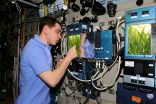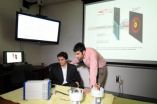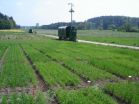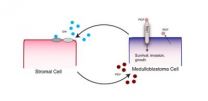CAPE CANAVERAL, FL, March 01, 2013 (Press-News.org) Some of the research on the International Space Station focuses on meeting the needs of long-term spaceflight to destinations such as asteroids or Mars. A group of engineers at NASA's Kennedy Space Center in Florida is developing a plant habitat with a large growth chamber to learn the effects of long-duration microgravity exposure to plants in space.
Through most of Kennedy's history, the space center has focused on receiving, processing and launching vehicles developed at other centers. Design projects such as the plant habitat give people at the Florida spaceport an opportunity to further use their extensive knowledge base in preparing flight hardware.
"This is the first Kennedy-led space station payload of this magnitude," said Bryan Onate, Plant Habitat Project manager in the ISS Ground Processing and Research Directorate. "We're using in-house expertise to develop the plant habitat to go on an EXPRESS rack in the station's Destiny laboratory. It will provide a large, enclosed, environmentally-controlled chamber designed to support commercial and fundamental plant research onboard the space station."
The plant habitat is configured as a payload that will be mounted on a standard Expedite the Processing of Experiments to Space Station, or EXPRESS, rack. The multipurpose payload rack system stores and supports research and science experiments across many disciplines by providing structural interfaces, power, data, cooling, water and other needs to operate science payloads in orbit.
The compact facility is about 21 inches high, 36 inches wide and 24 inches deep and would use about 735 watts of power.
"NASA is conducting plant research aboard the space station because during future long-duration missions, life in space may depend on it," Onate said.
As NASA plans missions beyond low-Earth orbit, relying on plant growth aboard a spacecraft will play an important role.
"The ability of plants to provide high quality science within a tightly closed system, a source of food and recycle carbon dioxide into breathable oxygen may prove crucial for astronauts and add to the body of knowledge as they live in space for months at a time," he said.
Onate explained that most of the experiments conducted on the space station are developed by principal investigators from universities or other research institutions.
"The plant habitat is an effort to attract a broader audience of principle investigators that need a large growth area for a long duration," he said. "In order to expedite this capability on the space station, we have contracted with Orbital Technologies Corp. to help us design, fabricate and certify the plant habitat for flight."
Based in Madison, Wis., Orbital Technologies Corp., better known as ORBITEC, is a leading subsystems integrator and high-technology development company.
The plant habitat's design includes the ability to control temperature, humidity, carbon dioxide levels and lighting.
"Lighting is an important part of plant growth," Onate said. "We're using LEDs in this payload. Our experience shows that the LEDs work well in plant growth experiments in our labs here at Kennedy."
Within the plant habitat there is a tray called a science carrier that will hold various types of plants. The science carrier is a removable and reconfigurable tray that will provide the primary structural support and final water delivery to the root-zone for in-orbit plant growth experimentation.
The science carrier consists of a structural element, a water delivery mechanism, and a standard interface plate that will provide instrumentation support as part of the basic plant habitat capabilities. The carrier also will provide additional instrumentation interfaces for other experiment-specific measurement data required to allow investigators to extend the habitat's basic capabilities.
"Our design will allow principal investigators to modify the carriers depending on the type of plants they want to grow and the kind of experiments they have in mind," Onate said.
Plant habitat investigations can use the microgravity of space and can run 30, 60 or 90 days depending on the nature of the research.
"These trays will have a system of tubes allowing astronauts conducting the experiment to inject water and other plant nutrients into the media supporting plant growth," Onate said.
One of the next steps for the plant habitat is a preliminary design review in February. During the review, engineers will report on how the project is progressing to ensure the design meets system requirements within acceptable risk and falls within schedule and budget constraints.
"One of the design challenges we're dealing with now is the physical size and power requirements for the plant habitat," Onate said. "Weight, volume and maximizing valuable space station resources are always an important consideration for any payload designed for spaceflight."
"Launch of the Kennedy-designed plant habitat will likely go up on a SpaceX Dragon spacecraft," Onate said. "It is targeted for launch in December 2015."
For more information on past, ongoing, and future ISS research activities, including research results and publications, visit:
http://www.nasa.gov/mission_pages/station/research/index.html
If you are interested in subscribing to updates from the ISS Program Science Office, visit:
https://lists.nasa.gov/mailman/listinfo/iss-program-science-group
For more information about the International Space Station, visit:
http://www.nasa.gov/station
Kennedy Engineers Designing Plant Habitat For Space Station
RELEASE: JR13-012
2013-03-01
ELSE PRESS RELEASES FROM THIS DATE:
Neutron scattering provides data on adsorption of ions in microporous materials
2013-02-28
The adsorption of ions in microporous materials governs the operation of technologies as diverse as water desalination, energy storage, sensing and mechanical actuation. Until now, however, researchers attempting to improve the performance of these technologies haven't been able to directly and unambiguously identify how factors such as pore size, pore surface chemistry and electrolyte properties affect the concentration of ions in these materials as a function of the applied potential.
To provide the needed information, researchers at the Georgia Institute of Technology ...
Physicists demonstrate the acceleration of electrons by a laser in a vacuum
2013-02-28
Accelerating a free electron with a laser has been a longtime goal of solid-state physicists.
David Cline, a distinguished professor in the UCLA Department of Physics and Astronomy, and Xiaoping Ding, an assistant researcher at UCLA, have conducted research at Brookhaven National Laboratory in New York and have established that an electron beam can be accelerated by a laser in free space.
This has never been done before at high energies and represents a significant breakthrough, Cline said, adding that it also may have implications for fusion as a new energy source. ...
New protein quality method provides important information on sustainable diet
2013-02-28
Rosemont, IL (February 27, 2013) – A groundbreaking report by an Expert Consultation of the Food and Agriculture Organization of United Nations (FAO) has recommended a new, advanced method for assessing the quality of dietary proteins.
The report, "Dietary protein quality evaluation in human nutrition", recommends that the Digestible Indispensable Amino Acid Score (DIAAS) replace the Protein Digestibility Corrected Amino Acid Score (PDCAAS) as the preferred method of measuring protein quality. The report recommends that more data be developed to support full implementation, ...
Mutation location is the key to prognosis
2013-02-28
HOUSTON – (Feb. 28, 2013) – The three most important factors in real estate are location, location, location, and the same might be said for mutations in the gene MECP2, said researchers at Baylor College of Medicine and the Jan and Dan Duncan Neurological Research Institute (NRI) at Texas Children's Hospital in a report in the journal Cell.
"Where a mutation occurs can affect the severity of the symptoms of the disease," said Dr. Huda Zoghbi, professor of molecular and human genetics at BCM and director of the NRI. Zoghbi, corresponding author of the report, found the ...
UCLA study could explain why some people get zits and others don't
2013-02-28
The bacteria that cause acne live on everyone's skin, yet one in five people is lucky enough to develop only an occasional pimple over a lifetime. What's their secret?
In a boon for teenagers everywhere, a UCLA study conducted with researchers at Washington University in St. Louis and the Los Angeles Biomedical Research Institute has discovered that acne bacteria contain "bad" strains associated with pimples and "good" strains that may protect the skin.
The findings, published in the Feb. 28 edition of the Journal of Investigative Dermatology, could lead to a myriad ...
Action video games boost reading skills
2013-02-28
Much to the chagrin of parents who think their kids should spend less time playing video games and more time studying, time spent playing action video games can actually make dyslexic children read better. In fact, 12 hours of video game play did more for reading skills than is normally achieved with a year of spontaneous reading development or demanding traditional reading treatments.
The evidence, appearing in the Cell Press journal Current Biology on February 28, follows from earlier work by the same team linking dyslexia to early problems with visual attention rather ...
Fighting GM crop vandalism with a government-protected research site
2013-02-28
Genetically modified (GM) crops have been a source of great controversy—particularly in Europe—but acts of vandalism and associated security costs have made scientific evidence about the health and ecological impacts of those crops hard to come by. A Swiss government-protected field site dedicated for use in GM crop studies could serve as an example to other European countries interested in pursuing crop biotechnology, according to an article published in Trends in Biotechnology, a Cell Press publication, on February 28.
The protected field site will now enable research ...
Study identifies growth factor essential to the most common malignant pediatric brain tumor
2013-02-28
A multi-institutional team led by Massachusetts General Hospital (MGH) researchers has identified a molecular pathway that appears to be essential for the growth and spread of medulloblastoma, the most common malignant brain tumor in children. In their report in the Feb. 28 issue of Cell, they show that blocking this pathway – which involves interactions between tumor cells and the surrounding tissues – leads to regression of all four molecular subtypes of medulloblastoma in several mouse models.
"Our finding that a pathway carrying signals from host cells to tumor cells ...
How did early primordial cells evolve?
2013-02-28
VIDEO:
L-form bacteria undergoes cell division. The time scale is in minutes.
Click here for more information.
Four billion years ago, soon after the planet cooled enough for life to begin, primordial cells may have replicated and divided without protein machinery or cell walls, relying instead on just a flimsy lipid membrane. New research on bacteria examines exactly how these primitive cells could have evolved without such crucial structures. While the vast majority of bacteria ...
Animas' development of a first-generation closed loop insulin delivery system progresses
2013-02-28
WEST CHESTER, Pa., February 28, 2013 – Animas Corporation announced today positive results from the second phase of human clinical trials of a first-generation, closed-loop insulin delivery system in development, designed to predict a rise or fall in blood glucose and correspondingly increase, decrease, suspend and resume insulin delivery. The data were presented at the Advanced Technologies & Treatments for Diabetes (ATTD) Conference in Paris, France.
The feasibility study of the predictive Hypoglycemia-Hyperglycemia Minimizer (HHM) System* in development was conducted ...
LAST 30 PRESS RELEASES:
Scalable and healable gradient textiles for multi‑scenario radiative cooling via bicomponent blow spinning
Research shows informed traders never let a good climate crisis go to waste
Intelligent XGBoost framework enhances asphalt pavement skid resistance assessment
Dual-function biomaterials for postoperative osteosarcoma: Tumor suppression and bone regeneration
New framework reveals where transport emissions concentrate in Singapore
NTP-enhanced lattice oxygen activation in Ce-Co catalysts for low-temperature soot combustion
Synergistic interface engineering in Cu-Zn-Ce catalysts for efficient CO2 hydrogenation to methanol
COVID-19 leaves a lasting mark on the human brain
Scientists use ultrasound to soften and treat cancer tumors without damaging healthy tissue
Community swimming program for Black youth boosts skills, sense of belonging, study finds
Specific depressive symptoms in midlife linked to increased dementia risk
An ‘illuminating’ design sheds light on cholesterol
Who is more likely to get long COVID?
Study showcases resilience and rapid growth of “living rocks”
Naval Research Lab diver earns Office of Naval Research 2025 Sailor of the Year
New Mayo-led study establishes practical definition for rapidly progressive dementia
Fossil fuel industry’s “climate false solutions” reinforce its power and aggravate environmental injustice
Researchers reveal bias in a widely used measure of algorithm performance
Alcohol causes cancer. A study from IOCB Prague confirms damage to DNA and shows how cells defend against it
Hidden viruses in wastewater treatment may shape public health risks, study finds
Unlock the power of nature: how biomass can transform climate mitigation
Biochar reshapes hidden soil microbes that capture carbon dioxide in farmland
Reducing saturated fat intake shows mortality benefit, but only in high-risk individuals
Manta rays create mobile ecosystems, study finds
Study: Mixed results in using lipoic acid to treat progressive multiple sclerosis
Norbert Holtkamp appointed director of Fermi National Accelerator Laboratory
New agentic AI platform accelerates advanced optics design
Biologists discover neurons use physical signals — not electricity — to stabilize communication
Researchers discover that a hormone can access the brain by hitchhiking
University of Oklahoma researcher awarded funding to pursue AI-powered material design
[Press-News.org] Kennedy Engineers Designing Plant Habitat For Space StationRELEASE: JR13-012





